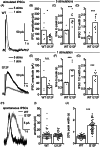A Gain-of-Function Variant in Dopamine D2 Receptor and Progressive Chorea and Dystonia Phenotype
- PMID: 33200438
- PMCID: PMC8049080
- DOI: 10.1002/mds.28385
A Gain-of-Function Variant in Dopamine D2 Receptor and Progressive Chorea and Dystonia Phenotype
Abstract
Background: We describe a 4-generation Dutch pedigree with a unique dominantly inherited clinical phenotype of a combined progressive chorea and cervical dystonia carrying a novel heterozygous dopamine D2 receptor (DRD2) variant.
Objectives: The objective of this study was to identify the genetic cause of the disease and to further investigate the functional consequences of the genetic variant.
Methods: After detailed clinical and neurological examination, whole-exome sequencing was performed. Because a novel variant in the DRD2 gene was found as the likely causative gene defect in our pedigree, we sequenced the DRD2 gene in a cohort of 121 Huntington-like cases with unknown genetic cause (Germany). Moreover, functional characterization of the DRD2 variant included arrestin recruitment, G protein activation, and G protein-mediated inhibition of adenylyl cyclase determined in a cell model, and G protein-regulated inward-rectifying potassium channels measured in midbrain slices of mice.
Result: We identified a novel heterozygous variant c.634A > T, p.Ile212Phe in exon 5 of DRD2 that cosegregated with the clinical phenotype. Screening of the German cohort did not reveal additional putative disease-causing variants. We demonstrated that the D2S/L -I212 F receptor exhibited increased agonist potency and constitutive activation of G proteins in human embryonic kidney 239 cells as well as significantly reduced arrestin3 recruitment. We further showed that the D2S -I212 F receptor exhibited aberrant receptor function in mouse midbrain slices.
Conclusions: Our results support an association between the novel p.Ile212Phe variant in DRD2, its modified D2 receptor activity, and the hyperkinetic movement disorder reported in the 4-generation pedigree. © 2020 The Authors. Movement Disorders published by Wiley Periodicals LLC on behalf of International Parkinson and Movement Disorder Society.
Keywords: chorea; dopamine D2 receptor; dystonia; hyperkinetic movement disorder.
© 2020 The Authors. Movement Disorders published by Wiley Periodicals LLC on behalf of International Parkinson and Movement Disorder Society.
Figures




Comment in
-
Reply to: "Childhood Onset Chorea Caused by a Recurrent De Novo DRD2 Variant".Mov Disord. 2021 Jun;36(6):1473-1474. doi: 10.1002/mds.28635. Mov Disord. 2021. PMID: 34145634 No abstract available.
-
Childhood-Onset Chorea Caused by a Recurrent De Novo DRD2 Variant.Mov Disord. 2021 Jun;36(6):1472-1473. doi: 10.1002/mds.28634. Mov Disord. 2021. PMID: 34145635 No abstract available.
Similar articles
-
Gait Abnormalities and Aberrant D2 Receptor Expression and Signaling in Mice Carrying the Human Pathogenic Mutation DRD2I212F.Mol Pharmacol. 2023 Mar;103(3):188-198. doi: 10.1124/molpharm.122.000606. Epub 2022 Dec 1. Mol Pharmacol. 2023. PMID: 36456191 Free PMC article.
-
Comparison of the function of two novel human dopamine D2 receptor variants identifies a likely mechanism for their pathogenicity.Biochem Pharmacol. 2024 Oct;228:116228. doi: 10.1016/j.bcp.2024.116228. Epub 2024 Apr 21. Biochem Pharmacol. 2024. PMID: 38643909
-
Childhood-Onset Chorea Caused by a Recurrent De Novo DRD2 Variant.Mov Disord. 2021 Jun;36(6):1472-1473. doi: 10.1002/mds.28634. Mov Disord. 2021. PMID: 34145635 No abstract available.
-
Chapter 33: the history of movement disorders.Handb Clin Neurol. 2010;95:501-46. doi: 10.1016/S0072-9752(08)02133-7. Handb Clin Neurol. 2010. PMID: 19892136 Review.
-
D2 dopamine receptor gene in psychiatric and neurologic disorders and its phenotypes.Am J Med Genet B Neuropsychiatr Genet. 2003 Jan 1;116B(1):103-25. doi: 10.1002/ajmg.b.10005. Am J Med Genet B Neuropsychiatr Genet. 2003. PMID: 12497624 Review.
Cited by
-
Differential diagnosis of chorea (guidelines of the German Neurological Society).Neurol Res Pract. 2023 Nov 23;5(1):63. doi: 10.1186/s42466-023-00292-2. Neurol Res Pract. 2023. PMID: 37993913 Free PMC article.
-
Subcellular localization of D2 receptors in the murine substantia nigra.Brain Struct Funct. 2022 Apr;227(3):925-941. doi: 10.1007/s00429-021-02432-3. Epub 2021 Dec 2. Brain Struct Funct. 2022. PMID: 34854963 Free PMC article.
-
Loss-of-Function Variants in DRD1 in Infantile Parkinsonism-Dystonia.Cells. 2023 Mar 30;12(7):1046. doi: 10.3390/cells12071046. Cells. 2023. PMID: 37048120 Free PMC article.
-
Investigating the role of striatal dopamine receptor 2 in motor coordination and balance: Insights into the pathogenesis of DYT1 dystonia.Behav Brain Res. 2021 Apr 9;403:113137. doi: 10.1016/j.bbr.2021.113137. Epub 2021 Jan 18. Behav Brain Res. 2021. PMID: 33476687 Free PMC article.
-
Genetic analysis of dystonia-related genes in Parkinson's disease.Front Aging Neurosci. 2023 May 26;15:1207114. doi: 10.3389/fnagi.2023.1207114. eCollection 2023. Front Aging Neurosci. 2023. PMID: 37304079 Free PMC article.
References
Publication types
MeSH terms
Substances
Grants and funding
LinkOut - more resources
Full Text Sources
Medical

